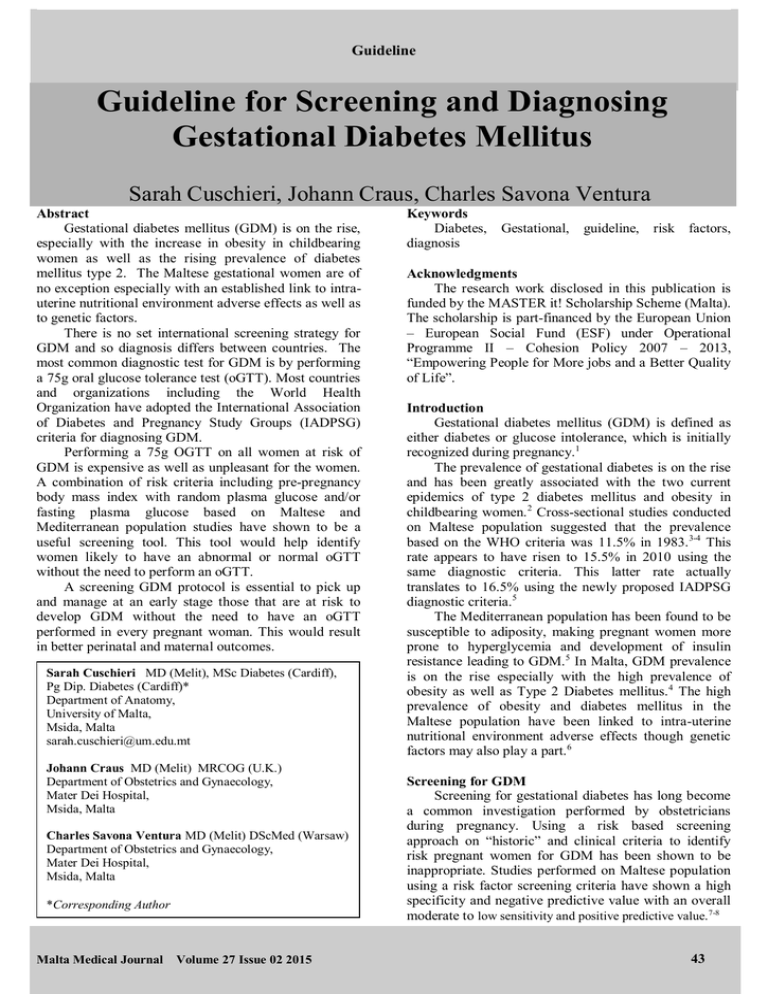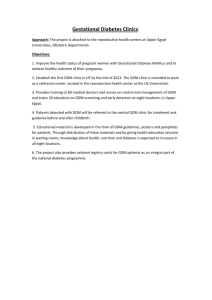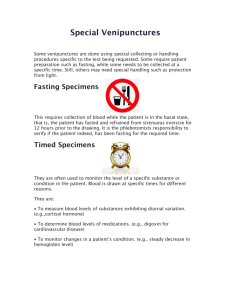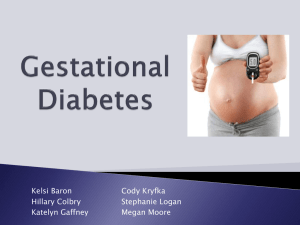Guideline
advertisement

Guideline Guideline for Screening and Diagnosing Gestational Diabetes Mellitus Sarah Cuschieri, Johann Craus, Charles Savona Ventura Abstract Gestational diabetes mellitus (GDM) is on the rise, especially with the increase in obesity in childbearing women as well as the rising prevalence of diabetes mellitus type 2. The Maltese gestational women are of no exception especially with an established link to intrauterine nutritional environment adverse effects as well as to genetic factors. There is no set international screening strategy for GDM and so diagnosis differs between countries. The most common diagnostic test for GDM is by performing a 75g oral glucose tolerance test (oGTT). Most countries and organizations including the World Health Organization have adopted the International Association of Diabetes and Pregnancy Study Groups (IADPSG) criteria for diagnosing GDM. Performing a 75g OGTT on all women at risk of GDM is expensive as well as unpleasant for the women. A combination of risk criteria including pre-pregnancy body mass index with random plasma glucose and/or fasting plasma glucose based on Maltese and Mediterranean population studies have shown to be a useful screening tool. This tool would help identify women likely to have an abnormal or normal oGTT without the need to perform an oGTT. A screening GDM protocol is essential to pick up and manage at an early stage those that are at risk to develop GDM without the need to have an oGTT performed in every pregnant woman. This would result in better perinatal and maternal outcomes. Sarah Cuschieri MD (Melit), MSc Diabetes (Cardiff), Pg Dip. Diabetes (Cardiff)* Department of Anatomy, University of Malta, Msida, Malta sarah.cuschieri@um.edu.mt Johann Craus MD (Melit) MRCOG (U.K.) Department of Obstetrics and Gynaecology, Mater Dei Hospital, Msida, Malta Charles Savona Ventura MD (Melit) DScMed (Warsaw) Department of Obstetrics and Gynaecology, Mater Dei Hospital, Msida, Malta *Corresponding Author Malta Medical Journal Volume 27 Issue 02 2015 Keywords Diabetes, diagnosis Gestational, guideline, risk factors, Acknowledgments The research work disclosed in this publication is funded by the MASTER it! Scholarship Scheme (Malta). The scholarship is part-financed by the European Union – European Social Fund (ESF) under Operational Programme II – Cohesion Policy 2007 – 2013, “Empowering People for More jobs and a Better Quality of Life”. Introduction Gestational diabetes mellitus (GDM) is defined as either diabetes or glucose intolerance, which is initially recognized during pregnancy.1 The prevalence of gestational diabetes is on the rise and has been greatly associated with the two current epidemics of type 2 diabetes mellitus and obesity in childbearing women. 2 Cross-sectional studies conducted on Maltese population suggested that the prevalence based on the WHO criteria was 11.5% in 1983. 3-4 This rate appears to have risen to 15.5% in 2010 using the same diagnostic criteria. This latter rate actually translates to 16.5% using the newly proposed IADPSG diagnostic criteria.5 The Mediterranean population has been found to be susceptible to adiposity, making pregnant women more prone to hyperglycemia and development of insulin resistance leading to GDM.5 In Malta, GDM prevalence is on the rise especially with the high prevalence of obesity as well as Type 2 Diabetes mellitus. 4 The high prevalence of obesity and diabetes mellitus in the Maltese population have been linked to intra-uterine nutritional environment adverse effects though genetic factors may also play a part.6 Screening for GDM Screening for gestational diabetes has long become a common investigation performed by obstetricians during pregnancy. Using a risk based screening approach on “historic” and clinical criteria to identify risk pregnant women for GDM has been shown to be inappropriate. Studies performed on Maltese population using a risk factor screening criteria have shown a high specificity and negative predictive value with an overall moderate to low sensitivity and positive predictive value. 7-8 43 Guideline Figure 1: Screening for diabetes during pregnancy Flow Chart FIRST VISIT Preferably before third trimester Measure weight & Height and Estimate BMI BMI <30 kg/m2 BMI >=30 kg/m2 Perform RBG Perform FBG >=11.1 mmol/l Consider as DM [confirm with repeat FBG] >=7.0 mmol/l 6.9 – 11.0 mmol/l Consider as GDM [after repeat FBG] 5.1 – 6.9 mmol/l 4.5 – 6.8 mmol/l Perform FBG & manage accordingly Perform 75g oGTT at 24-32 weeks <=4.4 mmol/l Consider as normal but dietary advice and weight checks throughout pregnancy: ideal gain 5-15 kg for women with a normal BMI 75gm oGTT diagnostic criteria Fasting: mmol/l 1 hour mmol/l 2 hours: Normal <5.0 <9.9 GDM >5.1 >10.0 <8.4 >8.5 mmol/l Any one abnormal result * pre-existing T1DM, T2DM & IGT or women with a past history of GDM should not have an oGTT repeated during pregnancy. Malta Medical Journal Volume 27 Issue 02 2015 4.5 – 5.0 mmol/l <=4.4 mmol/l & BMI >=30 kg/m2 <=4.4 mmol/l & BMI <30 kg/m2 Diagnostic classification Prepregnancy DM – known cases or elevated RBG/FBG values GDM – cases with past history of GDM, FBG >5.1 mmol/l; or two abnormal values on oGTT Hyperglycaemia – one elevated blood glucose level on oGTT at 1 hour or two hour endpoints 44 Guideline This was in keeping with other international studies.9-10 Therefore, since using risk factor criteria is not an ideal screening tool to identify GDM women, it has been recommended that universal screening with 75g- oral glucose tolerance test (oGTT) should ideally be performed. This may not however be the most costeffective course of management.8 There is no set international screening strategy, so that screening programmes for GDM varies from one country to another.11 In a Mediterranean population, the Mediterranean Group for the Study of Diabetes (MGSD) GDM study has identified that risk criteria showing a huge specificity and specificity and thus useful for screening include an elevated pre-pregnancy or third trimester maternal BMI (>25 and >30 kg/m2 respectively), a maternal age greater than 30 years, and a fasting plasma glucose [FBG] >5.1 mmol/l. All other previously described risk factors were found to be unsuitable with very low sensitivity values. 12 An untimed plasma glucose value of >6.8 mmol/l or <4.5mmol/L may also be a useful screening tool to identify women likely to have an abnormal or normal oGTT.13 A proposed screening flowchart is outlined below (Figure 1). This proposed screening programme is based on the IADSG and WHO-2013 proposed cut-off criteria for the oGTT in pregnancy 1,14 supplemented by the MGSD epidemiological studies related to GDM 12 and studies relating to the use of random plasma glucose [RBG] screening in the Maltese population. 13 An arbitrary RBG cut-off point of >6.0 mmol/l has been adopted to reduce the number of patients being inconvenienced by being recalled for an FBG. groups accordingly.18 This was subsequently adopted and modified by the American Diabetes Association (ADA).19 Many of the cut-off levels used to define GDM were based on 95% centile values of plasma glucose measures during an oGTT. The HAPO study carried out by the International Association of Diabetes and Pregnancy Study Groups (IADPSG) identified the cutoff criteria by looking at neonatal outcome by glucose values. 20 Similar observations have been made in a Mediterranean population. The World Health Organization has now adopted the IADPSG criteria. 14 Conclusions Screening for GDM is essential since the management of these women has been shown to result in better perinatal and maternal outcomes. Two large randomized interventional trials have confirmed that intervention may reduce the risk for developing fetal overgrowth, shoulder dystocia, hypertensive disorders and caesarean delivery was established.21-22 References 1. 2. 3. 4. Diagnostic criteria for GDM As there is no set international screening strategy, likewise the criteria used to diagnose GDM and the interpretation of the 75g oGTT varies from one country to another.11 The most common GDM diagnostic test to be performed is the oral glucose tolerance test (oGTT), usually performed during the 24 – 28 weeks of gestation.15 If the mother is considered to be at a high risk to develop GDM, this test may be done much earlier in her pregnancy. Stratification whether the mother is at high risk or not, comes from the first antenatal visit to the obstetrician, where a detailed medical, family and past obstetric history and a physical examination would be performed. 17 A fasting or untimed plasma glucose with or without a glycosated haemoglobin estimation may also be performed to identify early pre-pregnancy undiagnosed diabetic women. Over the years, different oGTT approaches and thresholds had been established. The 2-step approach takes its origin back to the 1964 O’ Sullivan et al. study which has been adapted over the years by different Malta Medical Journal Volume 27 Issue 02 2015 5. 6. 7. 8. 9. 10. World Health Organization. Diagnostic Criteria and Classification of Hyperglycaemia First Detected in Pregnancy Geneva: WHO, 2013. Lawrence J.M Contreras R, Chen W, Sacks D.A. Trends in the prevalence of preexisting diabetes and gestational diabetes mellitus among a racially/ethically diverse population of pregnant women, 1999-2--5. Diabetes Care. 2008;31(5):899 904. Katona G Aganovic I, Vuskan V, Skrabalo Z. National Diabetes Programme in Malta: Phase 1 and II Final Report. World Health Organisation 1983 Contract No.: (WHO NCD/OND/DIAB/83.2). Savona-Ventura Schranz AG, Chazan B. The clinical significance of gestational impaired glucose tolerance in the Maltese population. Arch Perinatal Med. 1997;3:55 - 64. Craus J, Savona-Ventura C, Vassallo J. Prevalence of GDM in the Maltese Population. Scientific Programme & Abstract – 12th Meeting of the Mediterranean Group for the Study of Diabetes, April 28 – May 1, 2011. MGSD, Paris, 2011 Savona-Ventrura C Marre M, Vassallo J, Karamonos B, MGSD-GDM study group. Obstetric adiposity in the Mediterranean region. International Journal of Gynaecology and Obstetrics. 2013;122(1):80 - 1. Savona Ventura C. The Thrifty Diet Phenotype - A Case for endogenous physiological teratogenesis. In: Engels JV [ed]: Birth Defects: New Research Nova Science Publishers, USA. 2006:pp. 183 - 200. Abou-Hussein S. Allele Scoring of genetic risk in previous GDM. MSc thesis. Faculty of Medicine and Surgery, University of Malta, 2009 Savona-ventura C, Schranz AG, Chircop M. Risk factors for gestational impaired glucose tolerance in the Maltese population: a cross-sectional study. Journal of Obstetrics and Gynaecology. 2001;21(6):591 - 4. Savona-Ventura C, Azzopardi J, Sant R. Risk factors for gestational diabetes mellitus in the Maltese population: a population based study. International Journal of Risk & Safety Medicine. 2000;13:1 - 7. 45 Guideline 11. Coustan DR, Nelson C, Carpenter MW, Carr SR, Rotondo L. Maternal age and screening for gestational diabetes: a population bsed study. Obstetrics & Gynaecology. 1989;73:557 - 61. 12. Savona-Ventrura C, Marre M, Vassallo J, Karamonos B, MGSD-GDM study group. Hyperglycaemia in pregnancy in the Mediterranean women. Acta Diabetologica. 2013;49:473 80. 13. Cuschieri S. A screening protocol for gestational diabetes mellitus among a high risk population. MSc thesis. Faculty of Medicine, Cardiff University, Wales, 2014 14. Roglic G, Colagiuri S. Gestational Diabetes Melltius: Squaring the Circle. Diabetes Care 2014; 37 (6): e143 - e144 15. Barden TP, Knowles HC. Diagnosis of diabetes in pregnancy. Clinical Obstetrics and Gynaecology. 1981;24:3 - 19. 16. Buckley BS, Harreiter J, Damm O, Circoy R, Chico A, Simmons D et al. Gestational diabetes mellitus in Europe: Prevalence, current screening practice and barriers to screening. A review. Diabetic Medicine. 2013;29:844 - 54. 16. Salmasi AM Dancy M. The glucose tolerance test, but not HbA(1c), remains the gold standard in identifying unrecognised diabetes mellitus and impaired glucose tolerance in hypertensive subjects. Angiology. 2005;56(5):571 - 9. 17. Reece E.A, Leguizaman G, Wiznitzer. Gestational diabetes: the need for a common ground. The Lancet. 2009;373:1789 - 97. 18. O'Sullivan J, Mahan C. Criteria for the oral glucose tolerance test in pregnancy. Diabetes. 1964;13:278 - 85. 19. American Diabetes Association. Standards of medical care in diabetes - 2011. Diabetes Care. 2011;34(Supplement 1):S11 S61. 20. International Association of Diabetes and Pregnancy Study Groups Consensus Panel. International Assocaiation of Diabetes and Pregnancy Study Group recommendations on the diagnosis and classification of hyperglycemia in pregnancy. Diabetes Care. 2010;33:676. 21. Landon MB, Spong CY, Thom E, Carpenter MW, Ramin SM, Casey B et al. A Multicenter, Randomized Trail of Treatment for Mild Gestational Diabetes. New England Journal of Medicine. 2008;361:1339 - 48. 22. Crowther CA, Hiller JE, Moss JR, McPhee AJ, Jeffries WS, Robinson JS. Australian Carbohydrate intolerance Study in Pregnant Women (ACHOSI) Trail Group. Effect of treatment of gestational diabetes mellitus in pregnancy outcomes. New England Journal of Medicine. 2005;352:2477 - 86. Malta Medical Journal Volume 27 Issue 02 2015 46




